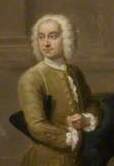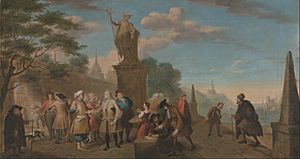John Theodore Heins facts for kids
Quick facts for kids
John Theodore Heins
|
|
|---|---|

self-portrait from the painting A Music Party at Melton Constable (1734)
|
|
| Born | c. 1697 Germany |
| Died | 1756 Norwich |
| Occupation | Painter |
| Children | John Heins |
John Theodore Heins (born around 1697, died 1756) was a talented artist. He was a painter and also made engravings. He was likely born in Germany but spent most of his career in Great Britain. He made his home in Norwich, England. By 1720, he was already busy painting pictures of important local families there.
Life as a Painter
Heins started working in Norwich around 1720. Records show he lived in Hog Hill in 1729. That year, he held a raffle where people could win three of his paintings. Some of his early artworks are signed "D. Heins." People believe the "D" stands for "Dietrich," which is the German version of "Theodore."
In 1732, Heins began painting portraits of important city officials in Norwich. Many of these paintings can still be seen today at Saint Andrew's Hall. He was the main artist for these city portraits until 1746. After that, another artist named Thomas Bardwell also started getting commissions.
Heins painted two portraits of the famous composer Handel, who had moved to England from Germany. Some of his best works were for the Astley family of Melton Constable. These included a painting of a "Musical Party" and a double portrait of Edward and Blanche Astley, who were children of Sir Jacob Astley. Heins also painted pictures about stories from history or myths. He created scenes lit by candlelight and everyday life scenes, like two paintings showing parts of the life of Thomas Guy.
In October 1745, a magazine called Gentleman's Magazine published a poem. It was titled "Lines on seeing some portraits of the celebrated Mr. Heyns of Norwich." This shows how well-known his work was at the time.
His Prints and Engravings
John Theodore Heins also made prints from his paintings. Joseph Strutt, who wrote a book about engravers in 1786, said that Heins made some of his portraits into mezzotints. A mezzotint is a type of print that creates soft, rich tones. Strutt felt Heins's style was a bit "stiff." Heins was also thought to have etched a few plates. Etching is another way of making prints using acid.
Strutt specifically mentioned one print by Heins. It was a portrait of Thomas Gooch, who was the Bishop of Norwich. This print was signed "Heins Pinx et fecit, 1741," which means Heins painted and made it in 1741.
John Theodore Heins Junior
John Theodore Heins had a son, also named John Heins. According to Strutt, the son first started learning to be a cloth manufacturer. However, he really wanted to be an artist, even though his parents didn't want him to. He became a painter of both large oil paintings and tiny miniature portraits.
His son was especially good at etching, or "scratching," as Strutt described it. This meant he created prints without using acid, just by drawing directly onto the plate with a sharp tool called a drypoint. He drew the pictures for a book called History of Ely by James Bentham. He also painted portraits, including a pair of a Mr. Grosse and his wife. John Theodore Heins Junior passed away in Chelsea around 1770.


